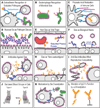Multifarious roles of sialic acids in immunity
- PMID: 22524423
- PMCID: PMC3357316
- DOI: 10.1111/j.1749-6632.2012.06517.x
Multifarious roles of sialic acids in immunity
Abstract
Sialic acids are a diverse family of monosaccharides widely expressed on all cell surfaces of vertebrates and so-called "higher" invertebrates, and on certain bacteria that interact with vertebrates. This overview surveys examples of biological roles of sialic acids in immunity, with emphasis on an evolutionary perspective. Given the breadth of the subject, the treatment of individual topics is brief. Subjects discussed include biophysical effects regulation of factor H; modulation of leukocyte trafficking via selectins; Siglecs in immune cell activation; sialic acids as ligands for microbes; impact of microbial and endogenous sialidases on immune cell responses; pathogen molecular mimicry of host sialic acids; Siglec recognition of sialylated pathogens; bacteriophage recognition of microbial sialic acids; polysialic acid modulation of immune cells; sialic acids as pathogen decoys or biological masks; modulation of immunity by sialic acid O-acetylation; sialic acids as antigens and xeno-autoantigens; antisialoglycan antibodies in reproductive incompatibility; and sialic-acid-based blood groups.
© 2012 New York Academy of Sciences.
Conflict of interest statement
The authors declare no conflicts of interest.
Figures


References
-
- Varki A, Schauer R. Sialic Acids. In: Varki A, Cummings RD, Esko JD, Freeze HH, Stanley P, Bertozzi CR, Hart GW, Etzler ME, editors. Essentials of Glycobiology. 2nd ed. Cold Spring Harbor, NY: Cold Spring Harbor Laboratory Press; 2009. pp. 199–218. - PubMed
-
- Severi E, Hood DW, Thomas GH. Sialic acid utilization by bacterial pathogens. Microbiology. 2007;153:2817–2822. - PubMed
Publication types
MeSH terms
Substances
Grants and funding
LinkOut - more resources
Full Text Sources
Other Literature Sources

